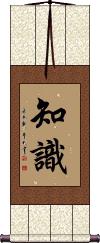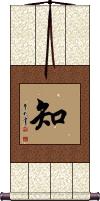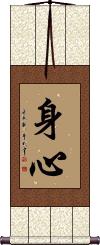Many custom options...
And formats...

Perception of Knowledge in Chinese / Japanese...
Buy a Perception of Knowledge calligraphy wall scroll here!
Personalize your custom “Perception of Knowledge” project by clicking the button next to your favorite “Perception of Knowledge” title below...
Perception of Knowledge
知識 has the very strong meaning of “knowledge” and, in some contexts, “learning.”
The first character represents “to know” or “to realize.”
The second character alone refers to the ability to “recognize” or “realize” and can also be used to mean “knowing.”
See Also: Wisdom | Learn From Wisdom
Realization and Knowledge
知 means realization or true knowing.
This can also translate as to know, to be aware, wisdom, or higher knowledge.
From older Buddhist ideas, this can represent विद्या (Vidyā or Vidya) or ज्ञान (Jñāna or Jnana) and even the combination Sanskrit word विज्ञान (Vijñāna or Vijnana) which can translate as wisdom arising from perception or knowing.
However, 知 should be distinguished as true knowing versus having a relative understanding or 會.
Body and Mind
身心 means “body and mind” or “mental and physical” in Chinese and Japanese.
In the Buddhist context, body and mind encompass the five elements (skandha) of a sentient being.
The body is the physical material (rūpa) of life. The mind embraces the other four skandhas, which are consciousness, perception, action, and knowledge.
This in-stock artwork might be what you are looking for, and ships right away...
Gallery Price: $61.00
Your Price: $33.88
Gallery Price: $61.00
Your Price: $33.88
Gallery Price: $61.00
Your Price: $33.88
Gallery Price: $61.00
Your Price: $33.88
Gallery Price: $61.00
Your Price: $33.88
Not the results for Perception of Knowledge that you were looking for?
Below are some entries from our dictionary that may match your Perception of Knowledge search...
| Characters If shown, 2nd row is Simp. Chinese |
Pronunciation Romanization |
Simple Dictionary Definition |
知 see styles |
zhī zhi1 chih tomoko ともこ |
More info & calligraphy: Realization and Knowledge(1) wisdom; (2) (Buddhist term) jnana (higher knowledge); (female given name) Tomoko To know. Sanskrit root vid, hence vidyā, knowledge; the Vedas, etc. 知 vijñā is to know, 智 is vijñāna, wisdom arising from perception or knowing. |
知識 知识 see styles |
zhī shi zhi1 shi5 chih shih tomoshiki ともしき |
More info & calligraphy: Perception of Knowledgeknowledge; information; (surname) Tomoshiki (1) To know and perceive, perception, knowledge. (2) A friend, an intimate. (3) The false ideas produced in the mind by common, or unenlightened knowledge; one of the 五識 in 起信論. |
身心 see styles |
shēn xīn shen1 xin1 shen hsin shinshin しんじん |
More info & calligraphy: Body and Mind(noun - becomes adjective with の) mind and body Body and mind, the direct fruit of the previous life. The body is rūpa, the first skandha; mind embraces the other four, consciousness, perception, action, and knowledge; v. 五蘊. |
受 see styles |
shòu shou4 shou uke うけ |
to receive; to accept; to suffer; subjected to; to bear; to stand; pleasant; (passive marker); (LGBT) bottom {Buddh} (See 五蘊,十二因縁) vedana (sensation); (place-name) Uke To receive, be, bear; intp. of vedana, 'perception,' 'knowledge obtained by the senses, feeling, sensation.' M. W. It is defined as mental reaction to the object, but in general it means receptivity, or sensation; the two forms of sensation of physical and mental objects are indicated. It is one of the five skandhas; as one of the twelve nidānas it indicates the incipient stage of sensation in the embryo. |
識 识 see styles |
zhì zhi4 chih tsuguhide つぐひで |
to record; to write a footnote (1) acquaintanceship; (2) {Buddh} vijnana; consciousness; (3) (after a signature) written by ...; (personal name) Tsuguhide vijñāna, "the art of distinguishing, or perceiving, or recognizing, discerning, understanding, comprehending, distinction, intelligence, knowledge, science, learning . . . wisdom." M.W. parijñāna, "perception, thorough knowledge," etc. M.W. It is intp. by 心 the mind, mental discernment, perception, in contrast with the object discerned; also by 了別 understanding and discrimination. There are classifications of 一識 that all things are the one mind, or are metaphysical; 二識 q. v. discriminating the ālaya-vijñāna or primal undivided condition from the mano-vijñāna or that of discrimination; 三識 in the Laṅkāvatāra Sutra, fundamental, manifested and discriminate; 五識 q.v. in the 起信論, i.e. 業, 轉, 現, 知, and 相續識; 六識 the perceptions and discernings of the six organs of sense; also of 8, 9, 10, and 11 識. The most important is the eight of the 起信論, i.e. the perceptions of the six organs of sense, eye, ear, nose, tongue, body (or touch), and mind, together with manas, intp. as 意識 the consciousness of the previous moment, on which the other six depend; the eighth is the ālaya-vijñāna, v. 阿賴耶, in which is contained the seed or stock of all phenomena and which 無沒 loses none, or nothing, is indestructible; a substitute for the seventh is ādāna 'receiving' of the 唯識, which is intp. as 無解 undiscriminated, or indefinite perception; there is a difference of view between the 相 and the 性 schools in regard to the seventh and eight 識; and the latter school add a ninth called the amala, or pure vijñāna, i.e. the non-phenomenal 眞如識. The esoterics add that all phenomena are mental and all things are the one mind, hence the one mind is 無量識 unlimited mind or knowledge, every kind of knowledge, or omniscience. vijñāna is one of the twelve nidānas.; Ālaya-vijñāna and mano-vijñāna; i. e. 阿梨耶 | and 分別事 |; v. 識. |
九地 see styles |
jiǔ dì jiu3 di4 chiu ti kuji くじ |
very low land; (surname) Kuji The nine lands, i.e. the 欲界 realm of desire or sensuous realm the four 色界 realms of form or material forms; and the four 無色界 formless realms, or realms beyond form; v. 九有, 九有情居, 禪 and 定. The nine realms are:—(1) 欲界五趣地; the desire realm with its five gati, i.e. hells, hungry ghosts, animals, men, and devas. In the four form-realms are:— (2) 離生喜樂地 Paradise after earthly life, this is also the first dhyāna, or subject of meditation, 初禪. (3) 定生喜樂地 Paradise of cessation of rebirth, 二禪. (4) 離喜妙樂地 Land of wondrous joy after the previous joys, 三禪. (5) 捨念淸淨地 The Pure Land of abandonment of thought, or recollection (of past delights), 四禪. The four formless, or infinite realms, catur arūpa dhātu, are:—(6) 空無邊處地 ākāśānantyā-yatanam, the land of infinite space; also the first samādhi, 第一定. (7) 識無邊處地 vijñānānamtyāyatanam, the land of omniscience, or infinite perception, 二定. (8) 無所有處地 ākiñcanyāyatana, the land of nothingness, 三定. (9) 非想非非想處地 naivasaṁjñānā-saṁjñāyatana, the land (of knowledge) without thinking or not thinking, or where there is neither consciousness nor unconsciousness, i.e. above either; this is the 四定. Eitel says that in the last four, "Life lasts 20,000 great kalpas in the 1st, 40,000 in the 2nd, 60,000 in the 3rd, and 80,000 great kalpas in the 4th of these heavens." |
五蘊 五蕴 see styles |
wǔ yùn wu3 yun4 wu yün goun / gon ごうん |
the Five Aggregates (from Sanskrit "skandha") (Buddhism) {Buddh} the five skandhas (matter, sensation, perception, mental formations and consciousness); the five aggregates The five skandhas, pañca-skandha: also 五陰; 五衆; 五塞犍陀 The five cumulations, substances, or aggregates, i. e. the components of an intelligent being, specially a human being: (1) 色 rūpa, form, matter, the physical form related to the five organs of sense; (2) 受 vedana, reception, sensation, feeling, the functioning of the mind or senses in connection with affairs and things; (3) 想 saṃjñā, conception, or discerning; the functioning of mind in distinguishing; (4) 行 saṃskāra, the functioning of mind in its processes regarding like and dislike, good and evil, etc.; (5) 識 vijñāna, mental faculty in regard to perception and cognition, discriminative of affairs and things. The first is said to be physical, the other four mental qualities; (2), (3), and (4) are associated with mental functioning, and therefore with 心所; (5) is associated with the faculty or nature of the mind 心王 manas. Eitel gives— form, perception, consciousness, action, knowledge. See also Keith's Buddhist Philosophy, 85-91. |
性識 性识 see styles |
xìng shì xing4 shi4 hsing shih shōshiki |
Natural powers of perception, or the knowledge acquired through the sense organs; mental knowledge. |
現識 现识 see styles |
xiàn shì xian4 shi4 hsien shih genshiki |
Direct knowledge, manifesting wisdom, another name of the ālayavijñāna, on which all things depend for realization, for it completes the knowledge of the other vijñānas. Also the 'representation-consciousness' or perception of an external world, one of the 五識 q.v. of the 起信論. |
知根 see styles |
zhī gēn zhi1 gen1 chih ken chikon |
The organs of perception. To know the roots, or capacities (of all beings, as does a bodhisattva; hence he has no fears). |
認識 认识 see styles |
rèn shi ren4 shi5 jen shih ninshiki にんしき |
to know; to recognize; to be familiar with; to get acquainted with sb; knowledge; understanding; awareness; cognition (noun, transitive verb) recognition; awareness; perception; understanding; knowledge; cognition; cognizance; cognisance to acknowledge, e.g. sin 認罪. |
四空定 see styles |
sì kōng dìng si4 kong1 ding4 ssu k`ung ting ssu kung ting shi kūjō |
四無色定 The last four of the twelve dhyānas; the auto-hypnotic, or ecstatic entry into the four states represented by the four dhyāna heavens, i. e. 四 空 處 supra. In the first, the mind becomes void and vast like space; in the second, the powers of perception and understanding are unlimited; in the third, the discriminative powers of mind are subdued; in the fourth, the realm of consciousness or knowledge) without thought is reached, e. g. intuitive wisdom. These four are considered both as states of dhyāna, and as heavens into which one who practices these forms of dhyāna may be born. |
毘闍那 毘阇那 see styles |
pí shén à pi2 shen2 a4 p`i shen a pi shen a bijana |
vijñāna, 毘若南 'consciousness or intellect', knowledge, perception, understanding, v. 識. |
識無處邊 识无处边 see styles |
shì wú chù biān shi4 wu2 chu4 bian1 shih wu ch`u pien shih wu chu pien shiki musho hen |
The brahmaloka of limitless knowledge or perception, v. 四空天 or 四空處 and 識處天. 識無處邊定 The dhyāna corresponding to it. 識無處邊解脫 The vimokṣa, or liberation from it to a higher stage. |
The following table may be helpful for those studying Chinese or Japanese...
| Title | Characters | Romaji (Romanized Japanese) | Various forms of Romanized Chinese | |
| Perception of Knowledge | 知識 知识 | chishiki | zhī shi / zhi1 shi / zhi shi / zhishi | chih shih / chihshih |
| Realization and Knowledge | 知 | chi | zhī / zhi1 / zhi | chih |
| Body and Mind | 身心 | shin jin / shinjin | shēn xīn / shen1 xin1 / shen xin / shenxin | shen hsin / shenhsin |
| In some entries above you will see that characters have different versions above and below a line. In these cases, the characters above the line are Traditional Chinese, while the ones below are Simplified Chinese. | ||||
Successful Chinese Character and Japanese Kanji calligraphy searches within the last few hours...











